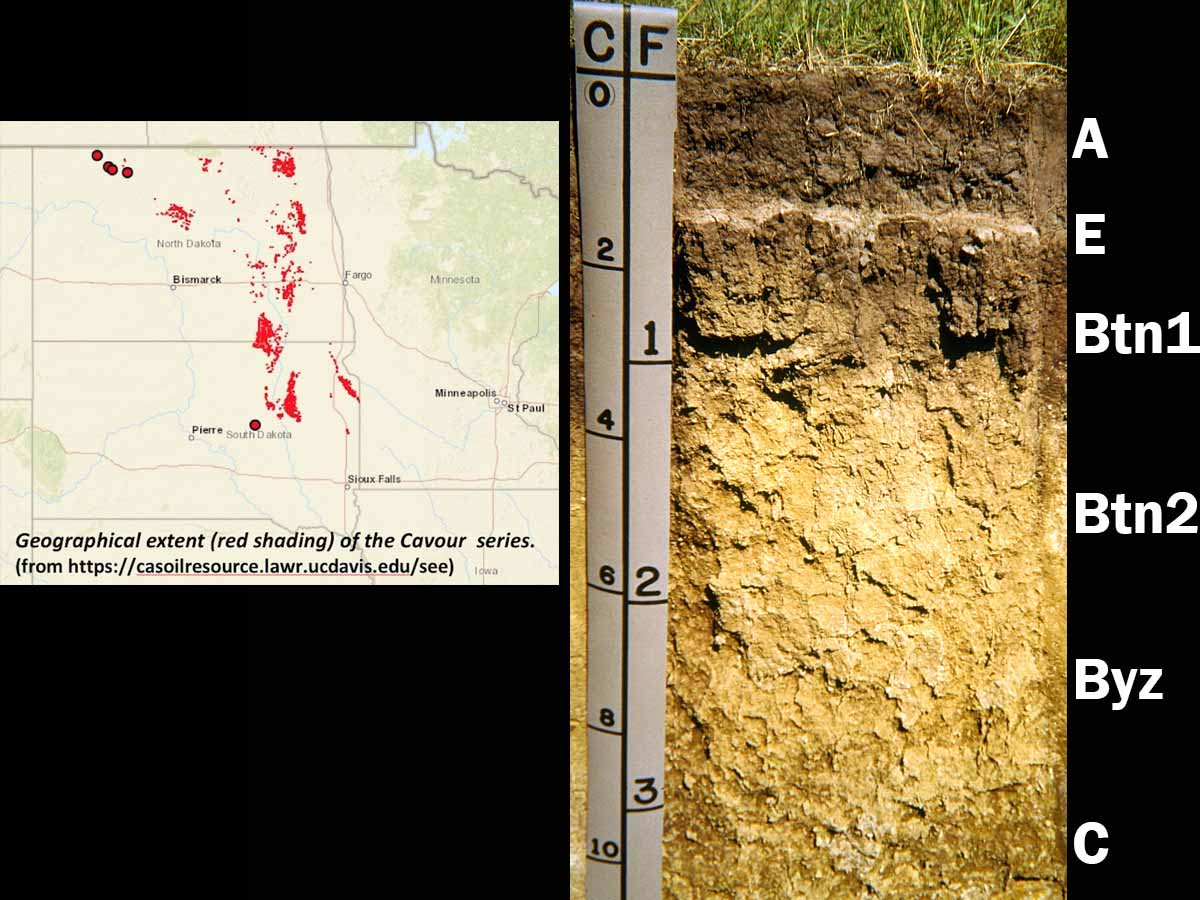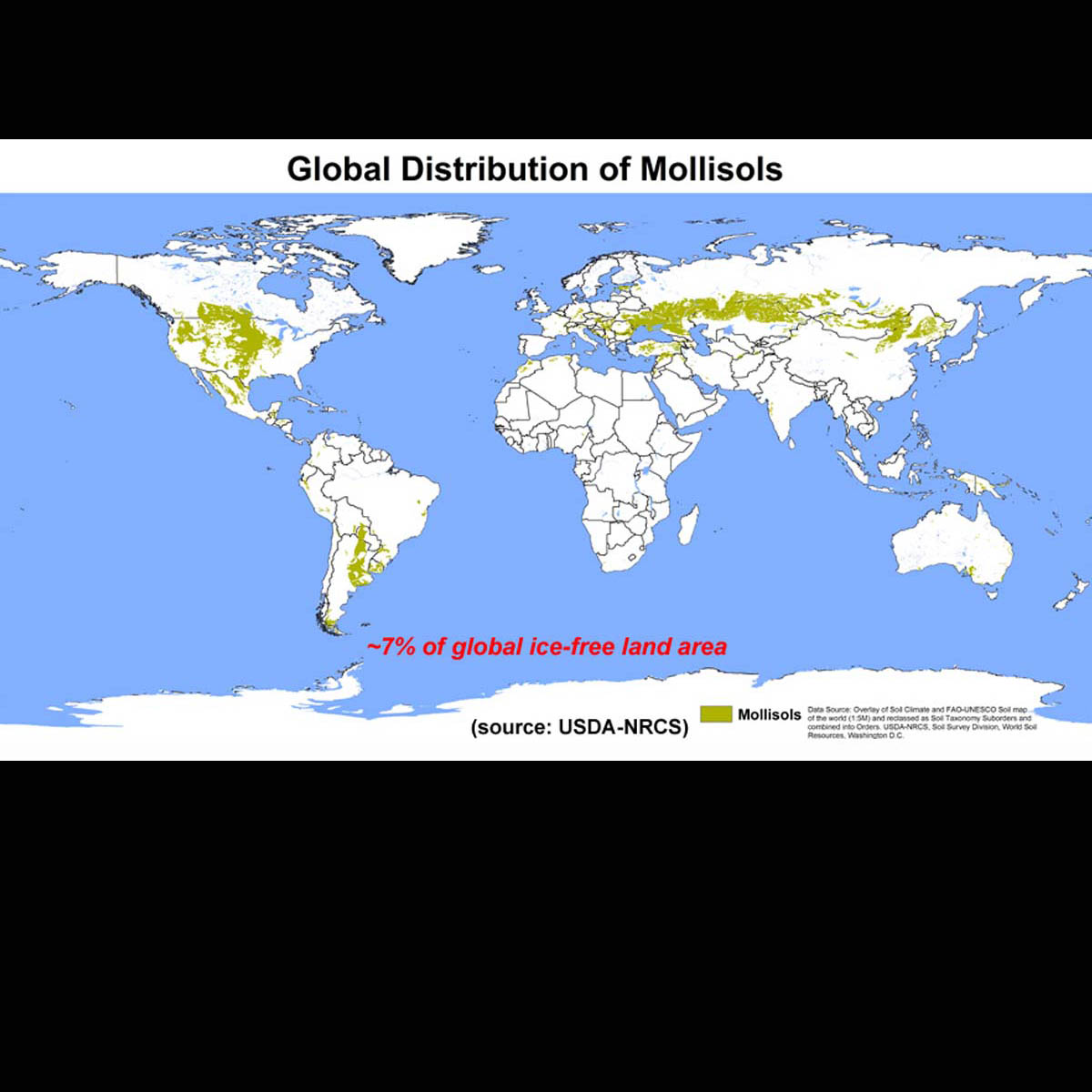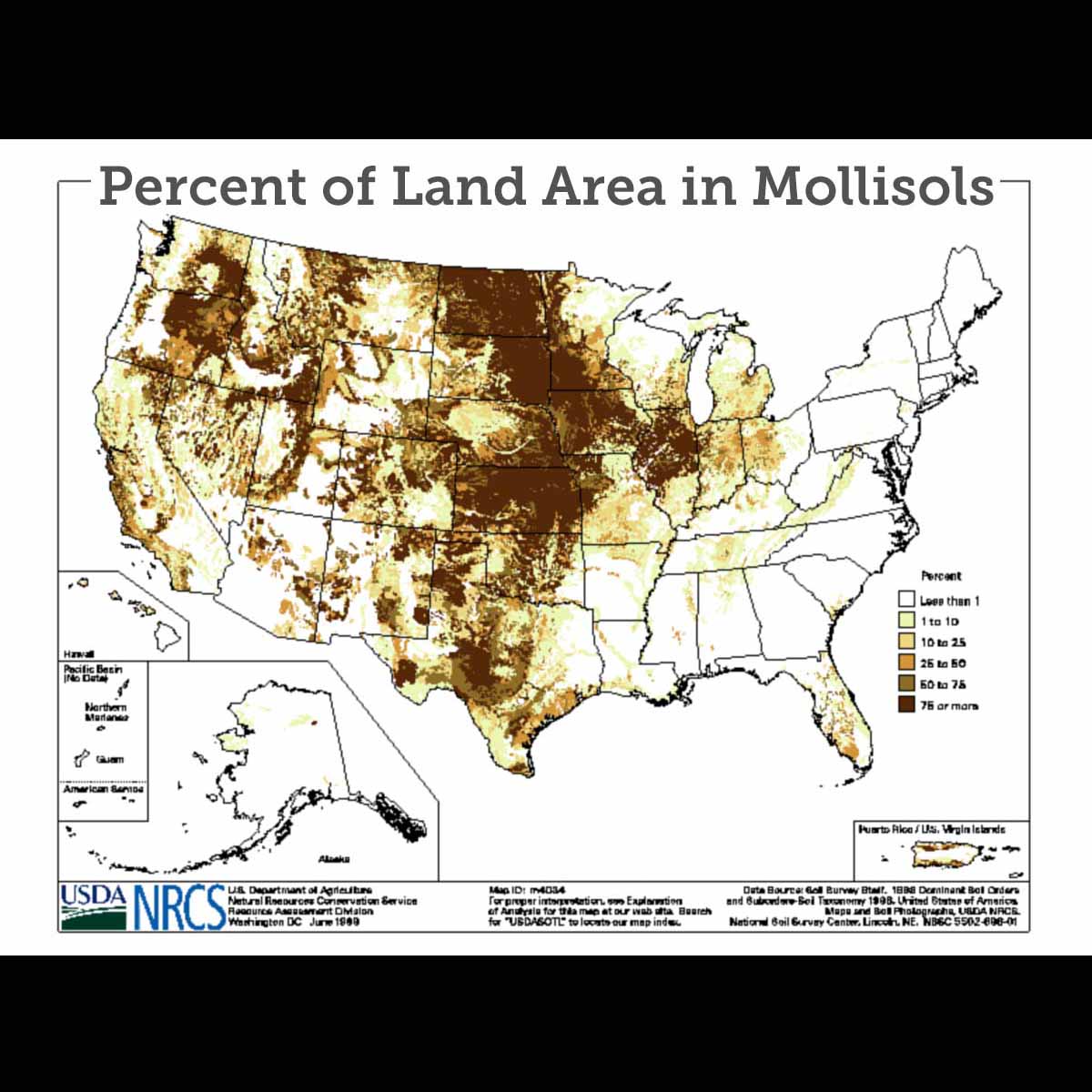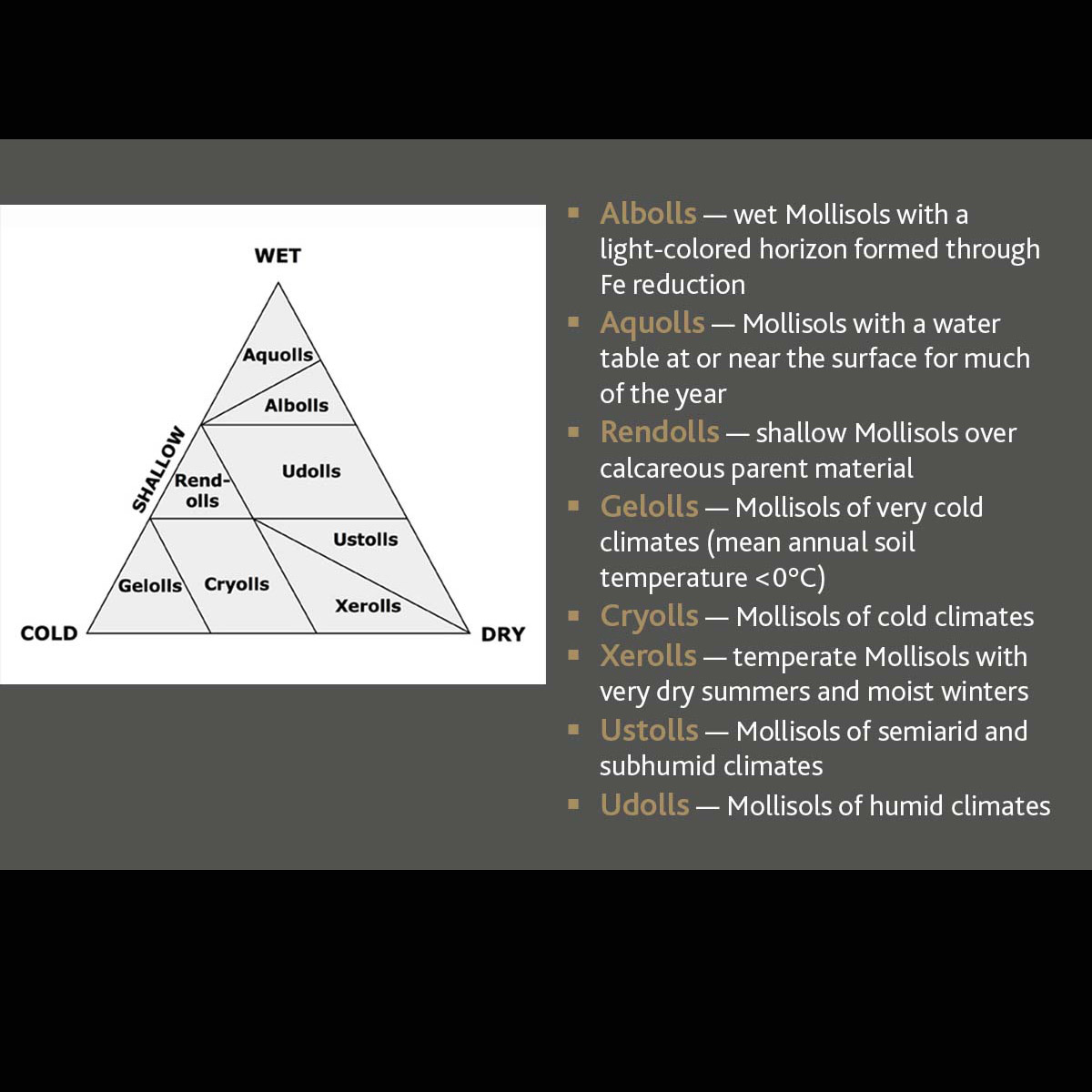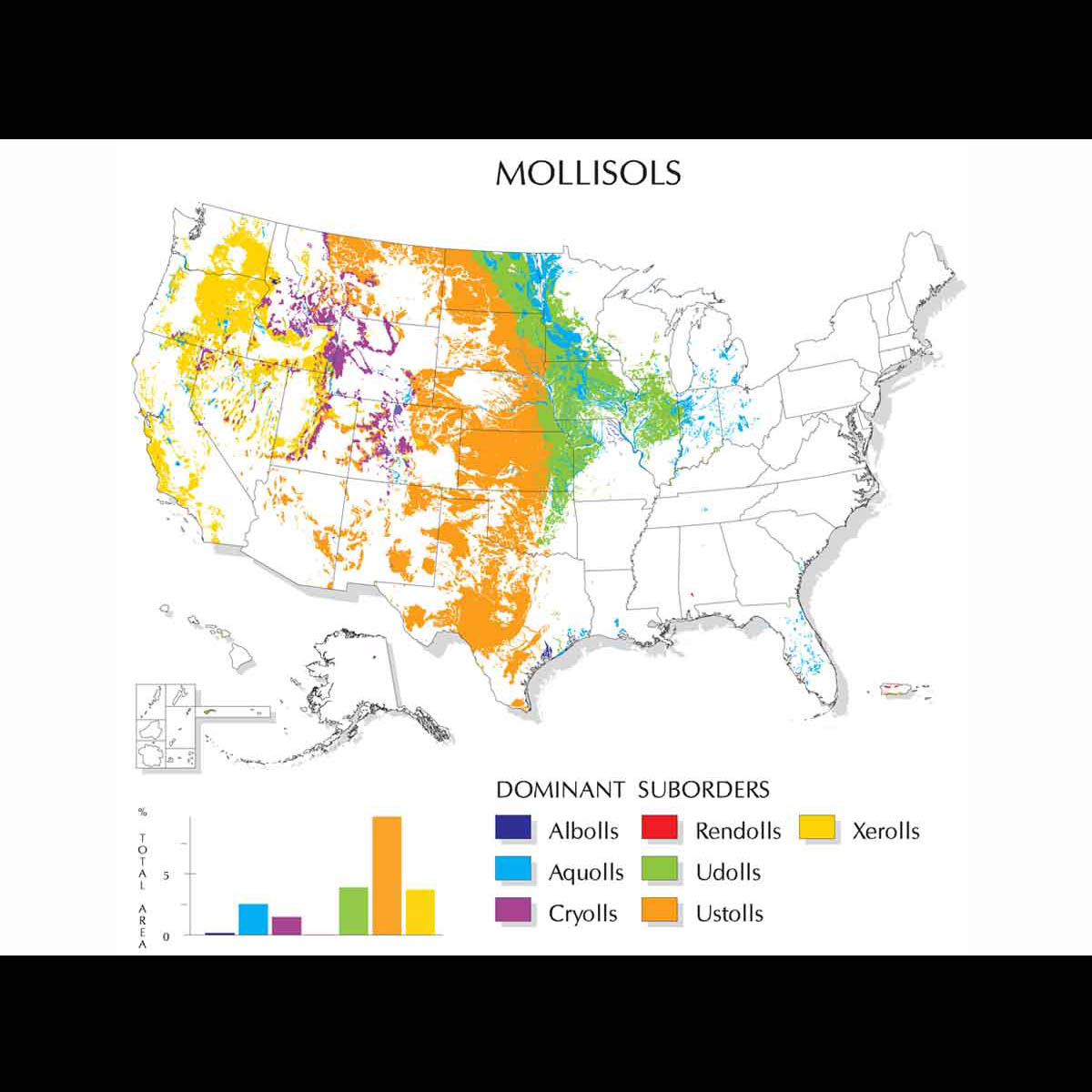Mollisols
Mollisols (from Latin mollis, "soft") are the soils of grassland ecosystems. They are characterized by a thick, dark surface horizon. This fertile surface horizon, known as a mollic epipedon, results from the long-term addition of organic materials derived from plant roots. Mollisols are among some of the most important and productive agricultural soils in the world and are extensively used for this purpose. They are divided into eight suborders: Albolls, Aquolls, Rendolls, Gelolls, Cryolls, Xerolls, Ustolls and Udolls.
Mollisols primarily occur in the middle latitudes and are extensive in prairie regions such as the Great Plains of the U.S. Globally, they occupy approximately 7.0% of the ice-free land area. In the U.S., they are the most extensive soil order, accounting for approximately 21.5% of the land area.

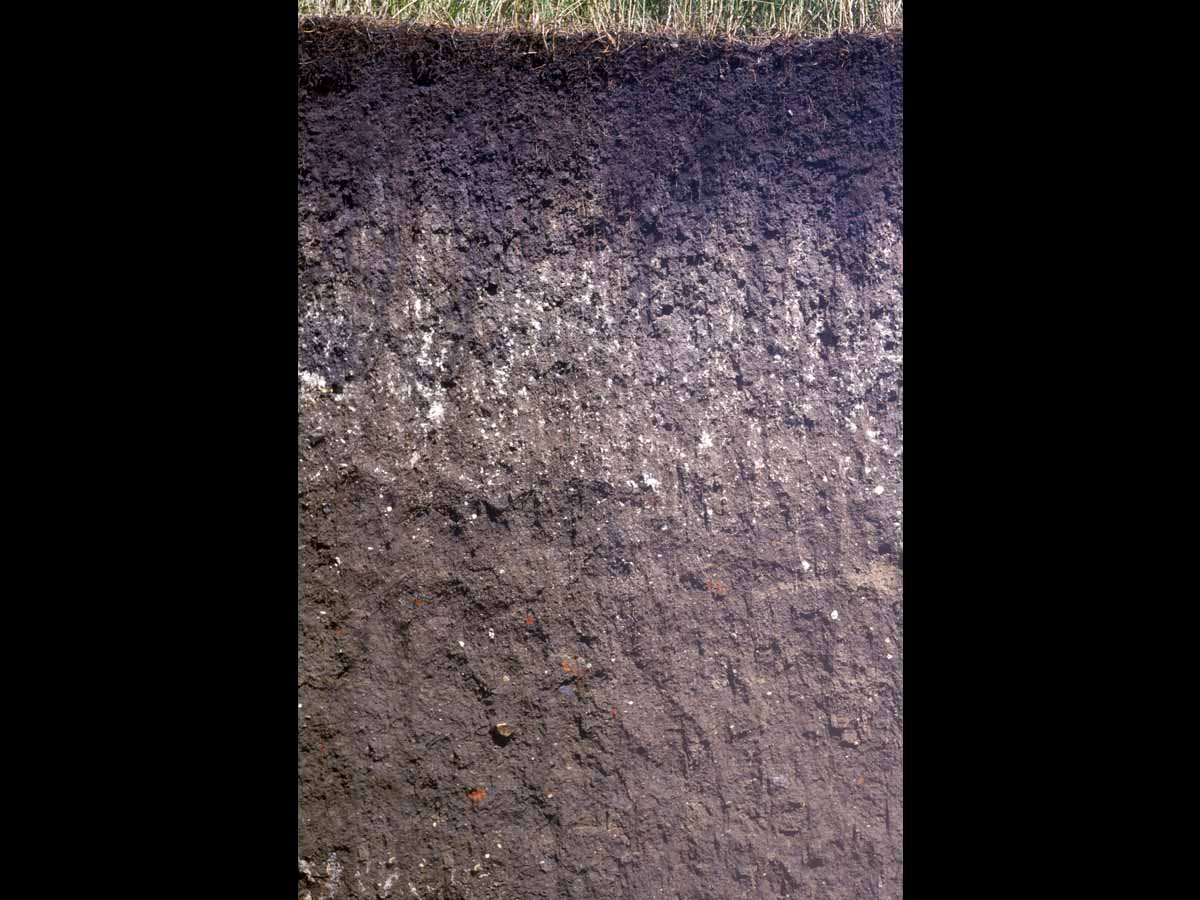
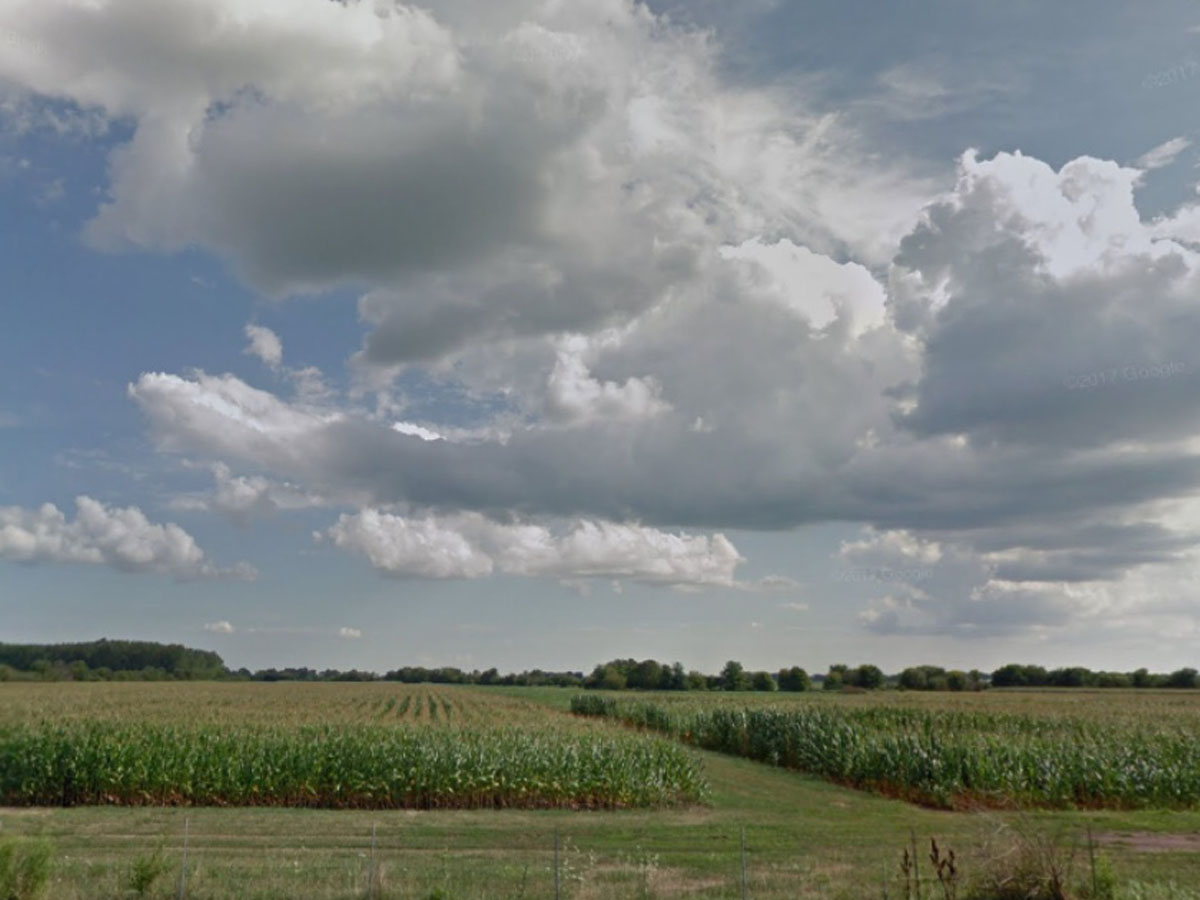
Aquoll/Udoll Landscape, central Illinois — This University of Illinois research farm is representative of the relatively low relief, glaciated till plain landscapes of Illinois and Iowa. Loess of varying thickness overlies glacial drift, and these serve as the dominant soil parent materials. Mean annual precipitation ranges from approximately 890 to 1090 mm (35-43 inches). Native prairie vegetation and scattered upland hardwood forests have largely been replaced by cropland with corn, soybeans and small grains among the major crops. (Image from Google Maps)
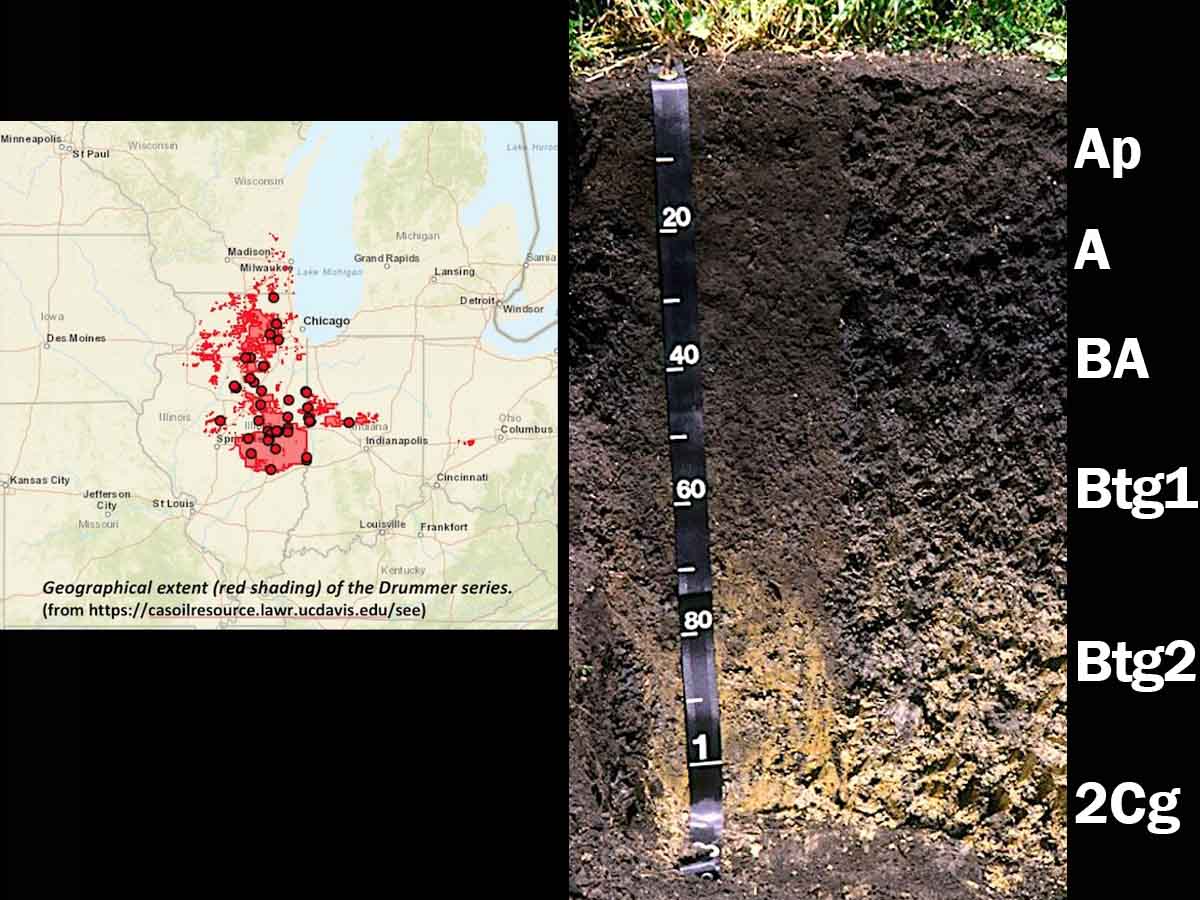
Typic Endoaquoll (fine-silty, mixed, superactive, mesic), Illinois — This very deep, poorly drained soil belongs to the Drummer series and is the state soil of Illinois. Drummer soils are the most extensive soils in the state and have formed in loess, silty sediments and glacial drift on nearly level outwash plains, terraces and till plains. Subsurface tile drainage is used to lower a seasonal water table and reduce the amount of time the upper root zone is saturated, thereby facilitating the use of these soils for crop production. Under native conditions Drummer soils support hydrophytic grasses, sedges and reeds. Scale is in centimeters. (Image from P. Buck, USDA-NRCS)
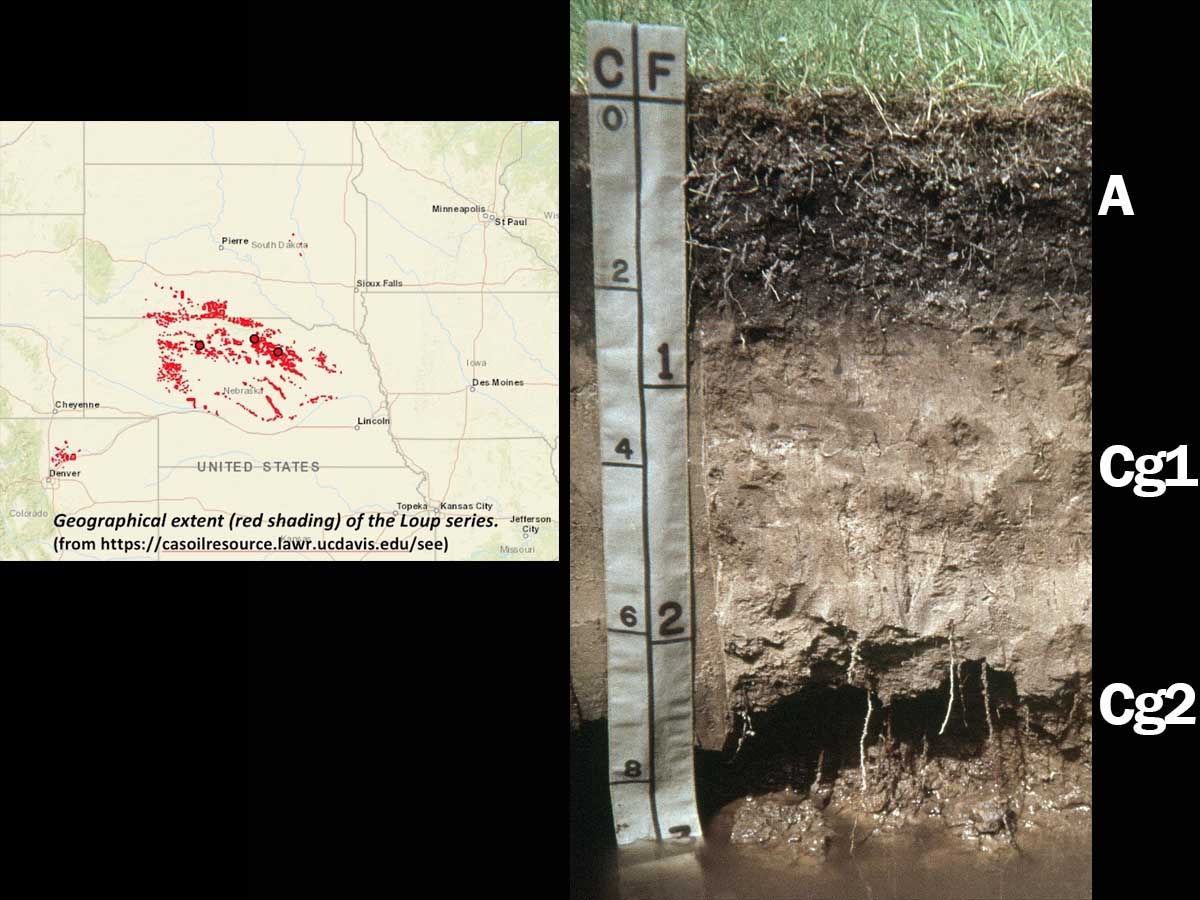
Typic Endoaquoll (sandy, mixed, mesic), Nebraska — This very deep, poorly drained soil is a member of the Loup series. These soils have formed in loamy and sandy alluvium and have a water table at or near the surface for much of the year. Because of the high water table, most of these soils remain in native grasses and are used for hay production and grazing. The dull colors of the Cg horizons result from prolonged periods of saturation in which Fe is reduced to more mobile, colorless forms. (Image reproduced from Soils of the Great Plains: Land Use, Crops and Grasses by Andrew R. Aandahl by permission of the University of Nebraska Press. Copyright 1982 by the University of Nebraska Press)
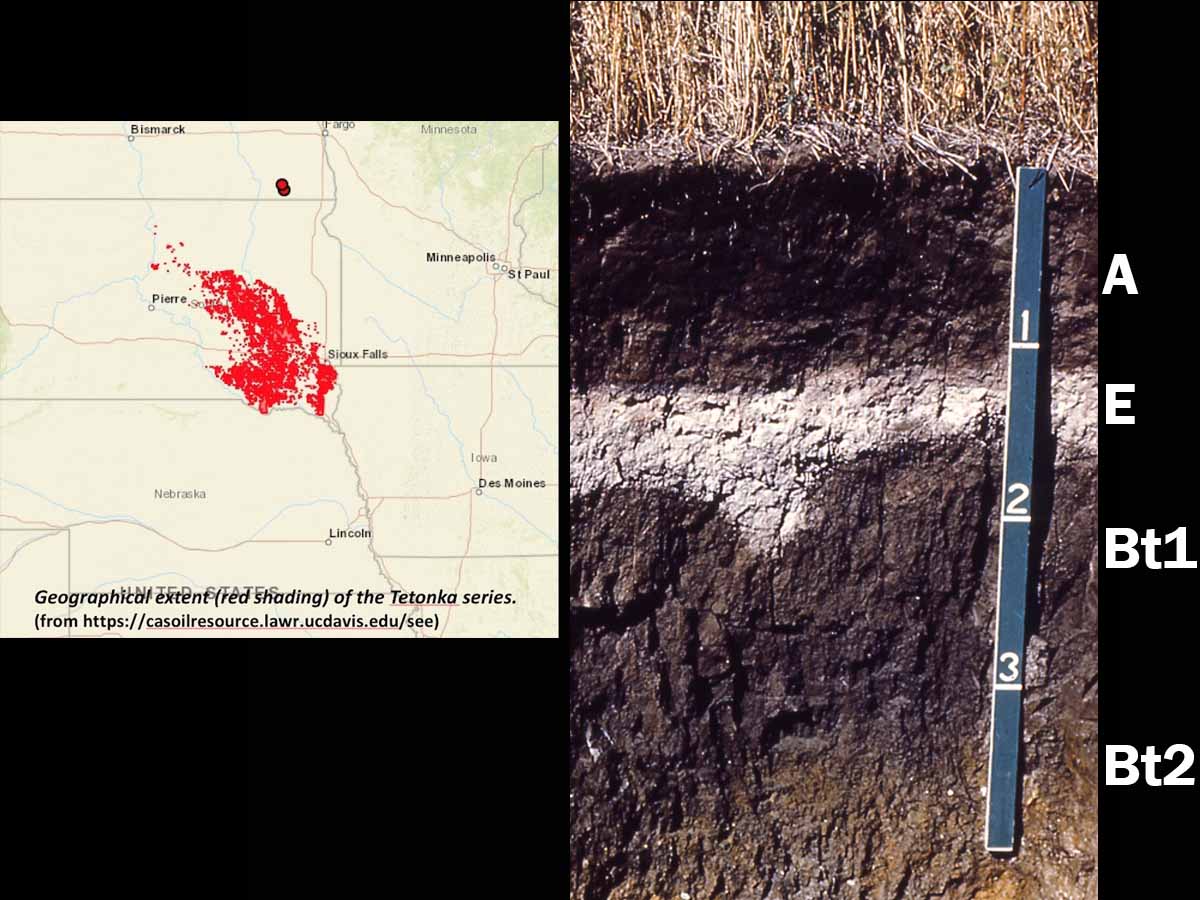
Argialboll, South Dakota — This poorly drained soil belongs to the Tetonka series and has formed in alluvium overlying glacial till in upland depressions and wide drainageways. Permeability is slow, and water ponds on the surface after heavy rains and snow melt. Soils typically are wet except in late summer and fall unless they have been drained. This striking profile consists of a clayey argillic Bt horizon that is overlain by a white albic E horizon. Where drained, these soils are commonly used for cultivated crops, including corn, soybeans, small grains and sorghum. Mean annual precipitation is approximately 510 mm (20 inches). Scale is in feet. (Image from the Soil Science Society of America Marbut Memorial Slide Set)
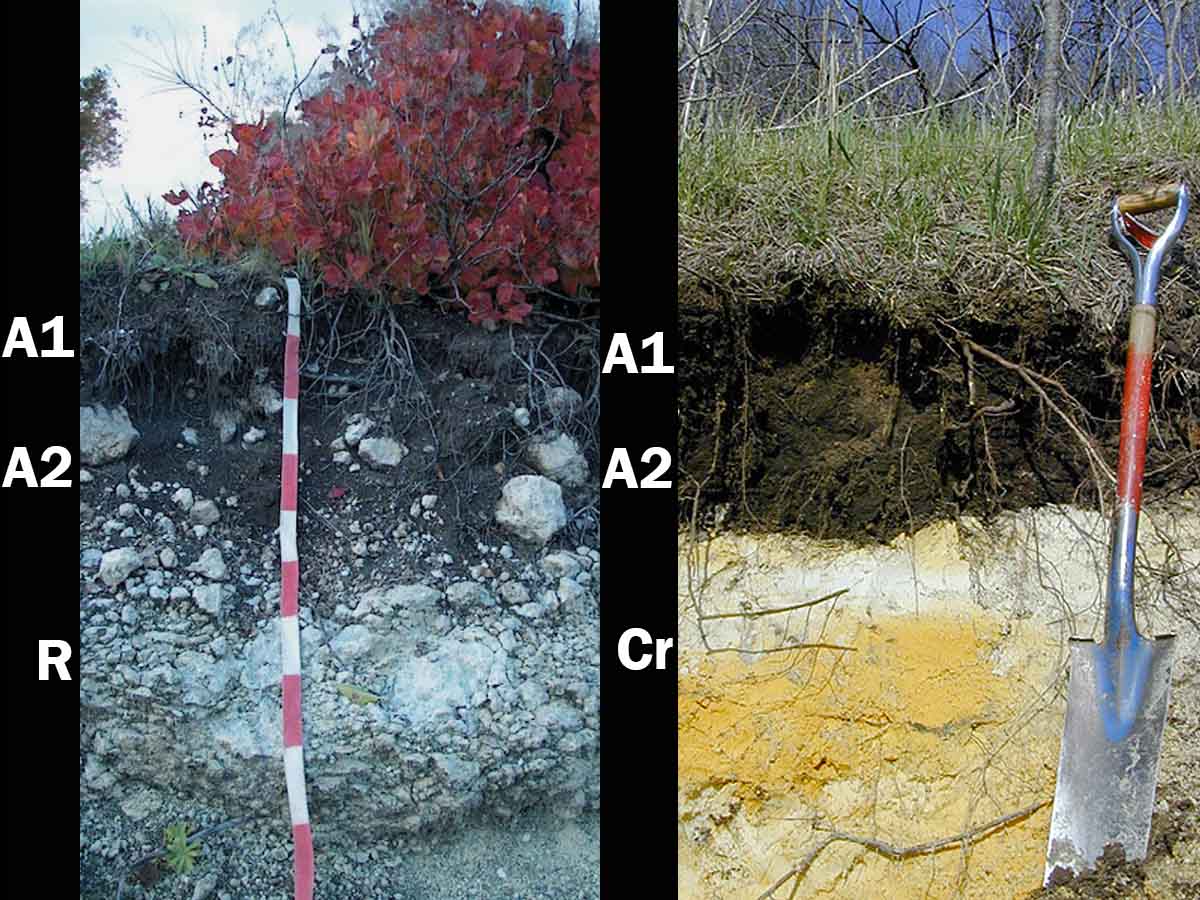
Rendolls — These shallow soils occur in humid climates and consist of very dark A horizons (mollic epipedons) directly overlying CaCO3-rich parent material. Left: This Rendoll from Europe has formed in limestone (Image from Soil Atlas of Europe, European Soil Bureau Network). Right: This Rendoll from southeastern Minnesota has formed in calcareous sedimentary deposits with mean annual precipitation of approximately 890 mm (35 inches). Rendolls are not extensive in the U.S. (Image from University of Idaho).
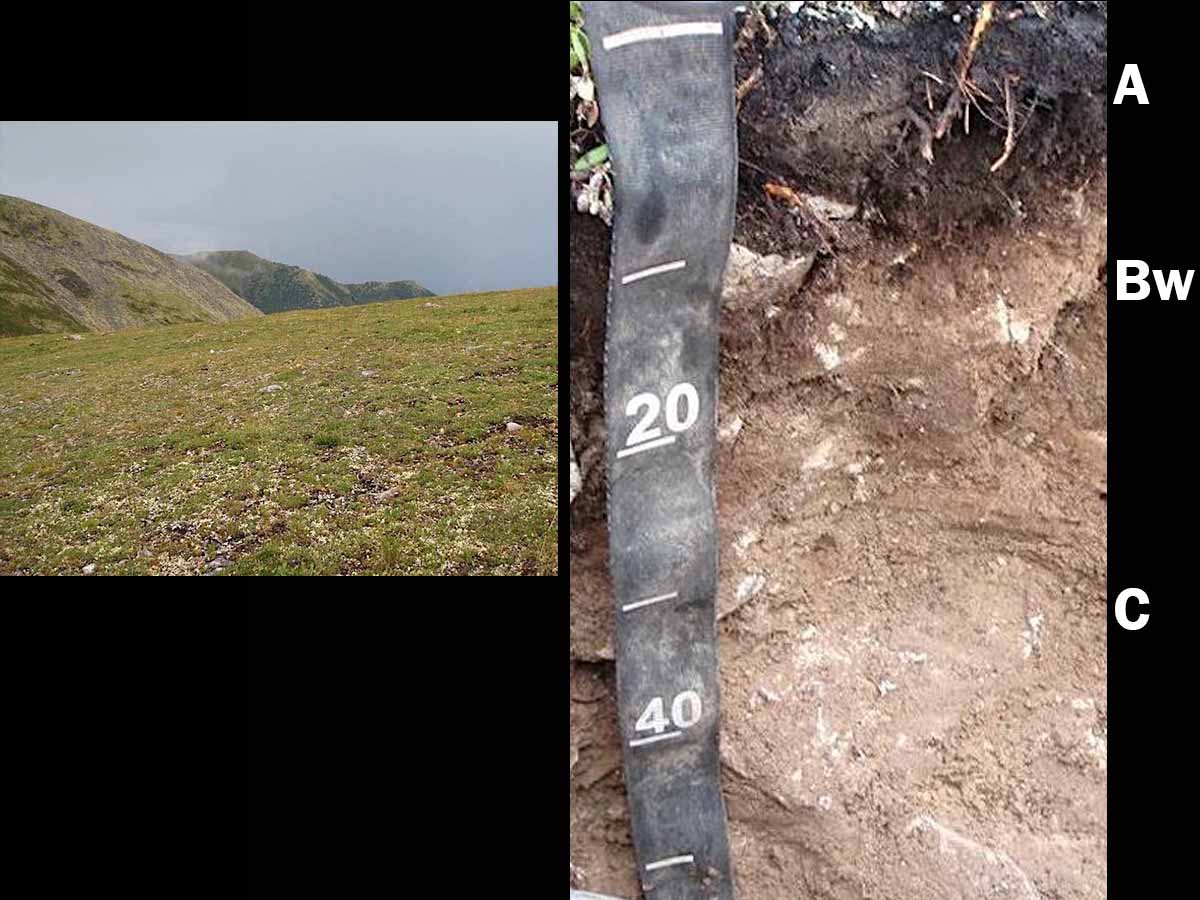
Geloll, interior Alaska — This landscape and soil are in the Interior Alaska Highlands approximately 80 km (50 miles) east of Fort Yukon. Mean annual precipitation is approximately 380-510 mm (15-20 inches) and mean annual temperature is approximately -5°C (23°F). Vegetation is a mosaic of alpine dwarf scrub and lichen. These rocky soils have a gelic temperature regime (mean annual soil temperature less than 0°C). However, they warm up enough in summer such that permafrost is deeper than 2 m below the surface and therefore they are not classified as Gelisols. This soil has formed in loess over gravelly cryoturbated deposits. Diagnostic features are limited to a mollic epipedon (A horizon). Scale is in decimeters. (Images from USDA-NRCS, Wasilla, AK)
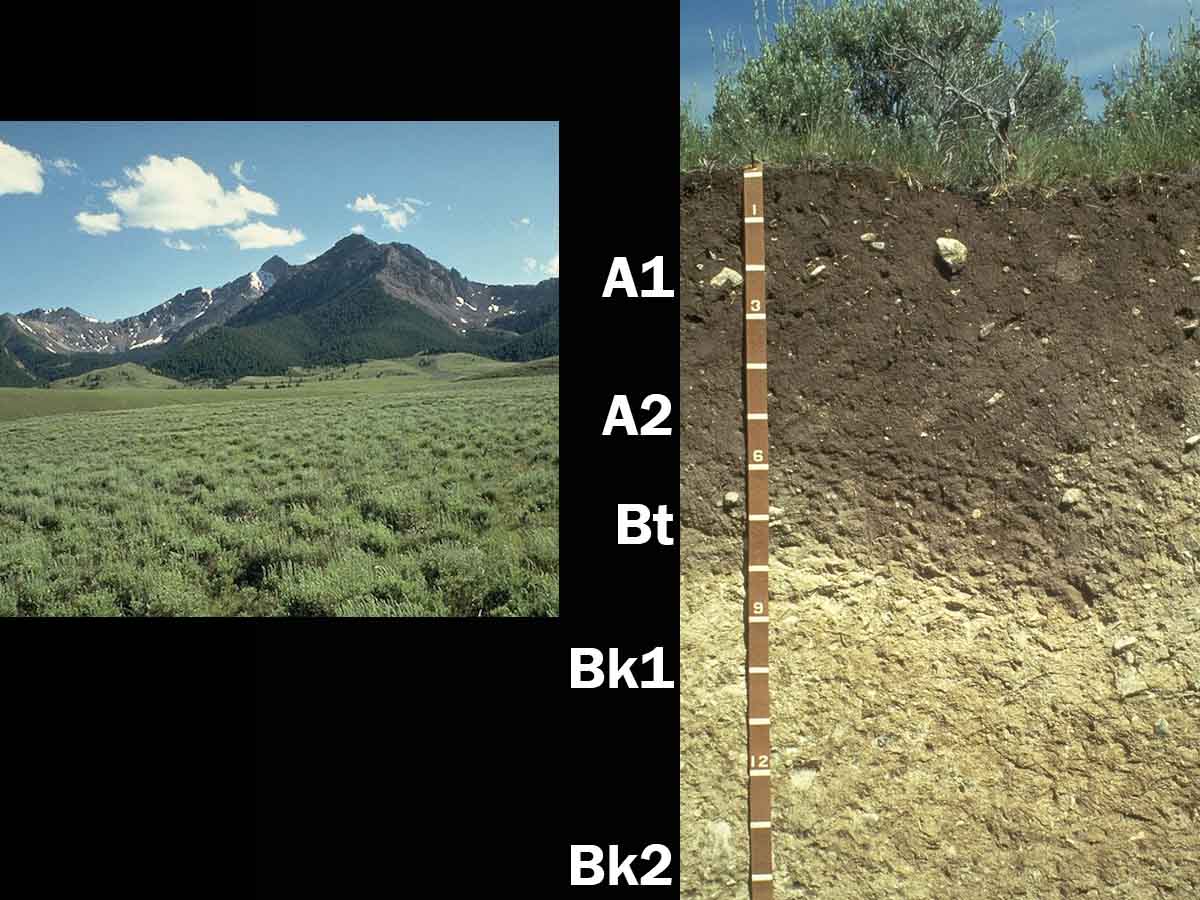
Pachic Argicryoll, eastern Idaho — This landscape and soil are found at elevations ranging from approximately 2,100-2,500 m (6,900-8,200 ft). Parent material is limestone colluvium and glacial outwash. Cold temperatures have slowed the decomposition of organic matter, resulting in a thick, dark mollic epipedon (A horizons) and classification in a Pachic subgroup. Some clay translocation and accumulation in the upper profile has occurred following the downward movement of carbonates. Wavy horizon boundaries can be seen on the right side of the profile. These are the result of extensive animal burrowing, possibly badger in this case. Scale is in decimeters. (Images from University of Idaho)
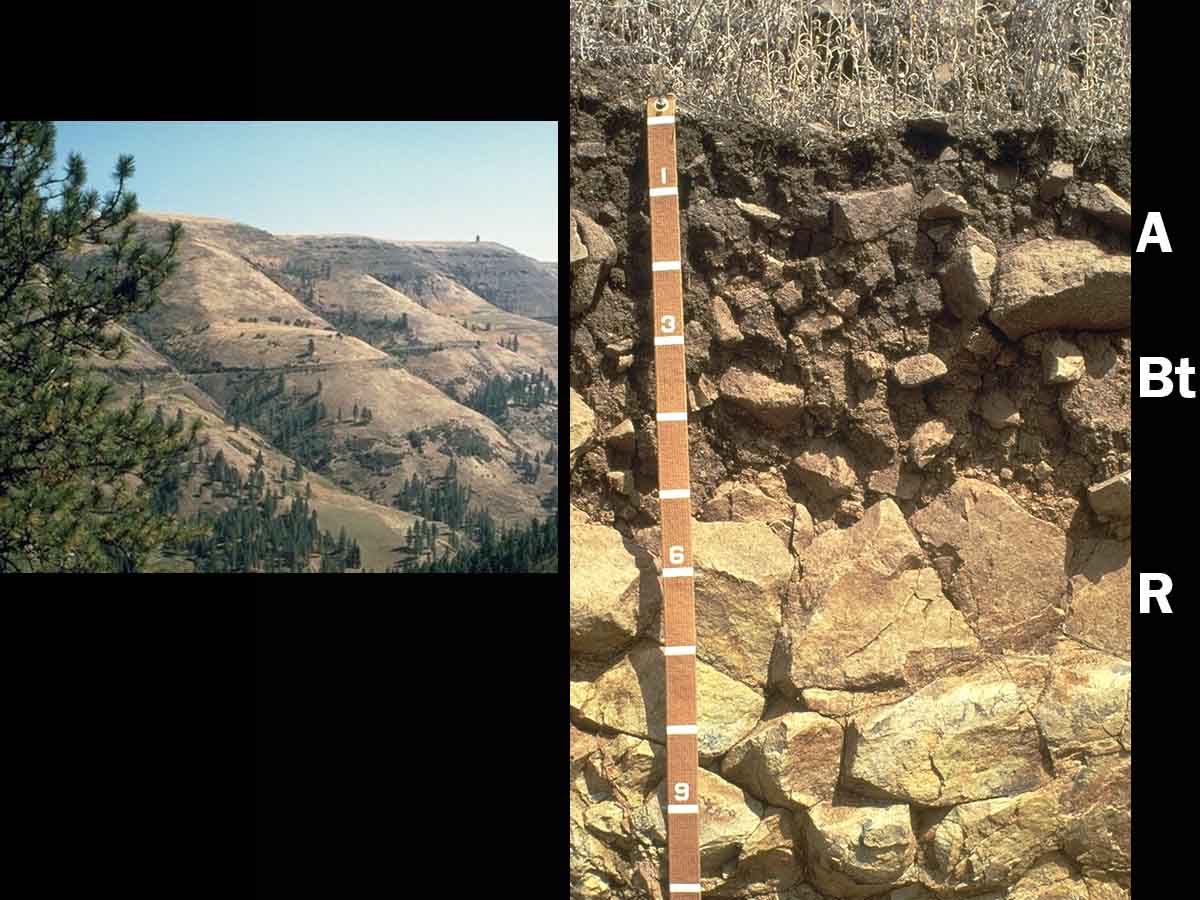
Lithic Argixeroll (loamy-skeletal, mixed, superactive, mesic), Nez Perce County, Idaho — This shallow soil is a member of the Gwin series and has formed in loess mixed with basalt colluvium. Mean annual precipitation is approximately 510 mm (20 inches). Gwin soils occupy the more stable bench positions seen in the landscape image allowing an argillic Bt horizon with 27-35 percent clay to form. The high percentage of rock fragments and shallow profile severely limit the total available-water-holding capacity of this soil. Primary land use is grazing and wildlife habitat. Scale is in decimeters. (Images from University of Idaho)
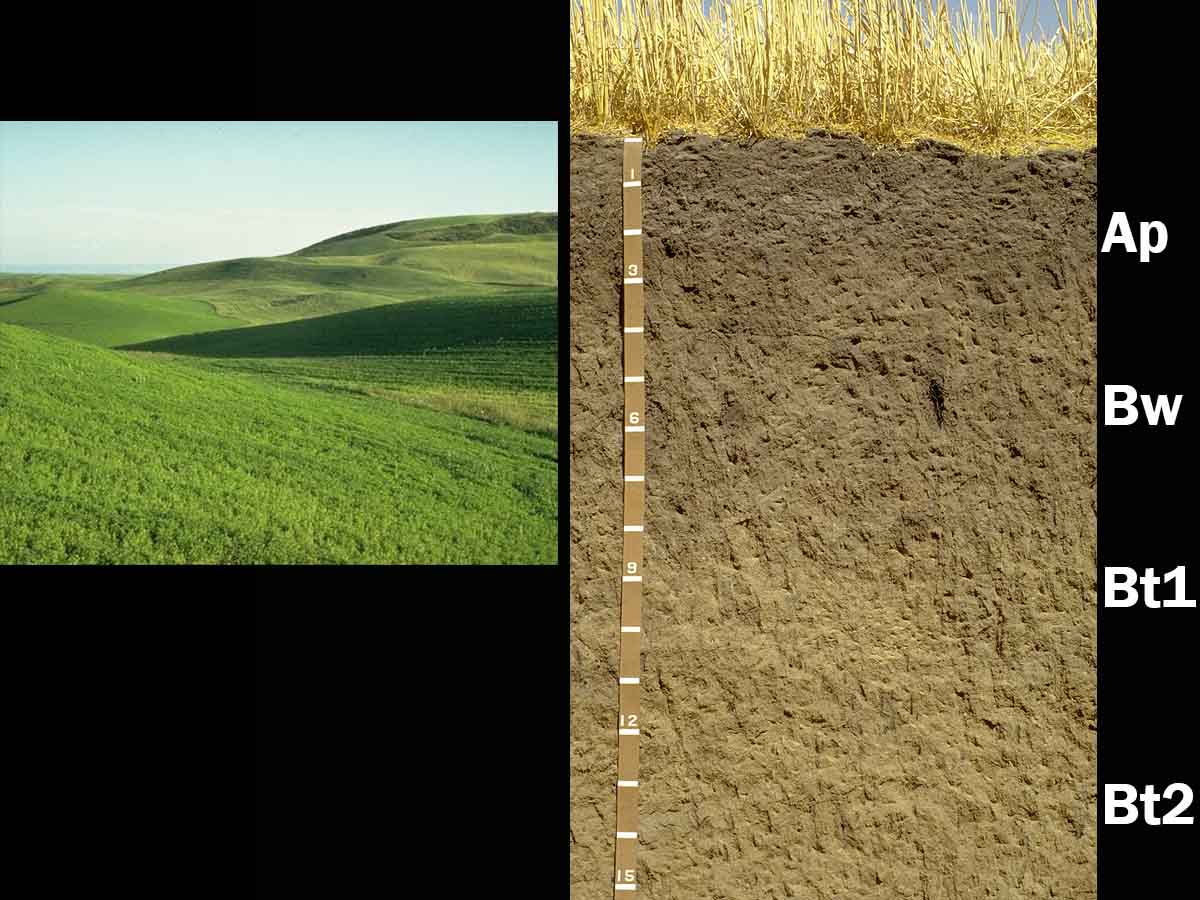
Pachic Ultic Haploxeroll (fine-silty, mixed, superactive, mesic), Latah County, Idaho This soil belongs to the Palouse series and is typical of the deep loess soils found in the Palouse region of eastern Washington and northern Idaho. Mean annual precipitation is approximately 530 mm (21 inches). Soils have formed under native grassland vegetation including Idaho fescue (Festuca idahoensis) and bluebunch wheatgrass (Pseudoroegneria spicata); however, very few areas of native vegetation remain due to the soil's high agricultural productivity. The Bt horizons do not qualify as an argillic horizon because the increase in clay is too gradual. The mollic epipedon is quite thick, extending from the surface to an average depth of approximately 60 cm. Crops grown on Palouse soils include winter wheat, barley, dry peas and lentils. Erosion is a major concern for the use and management of these soils. Scale is in decimeters. (Images from University of Idaho)
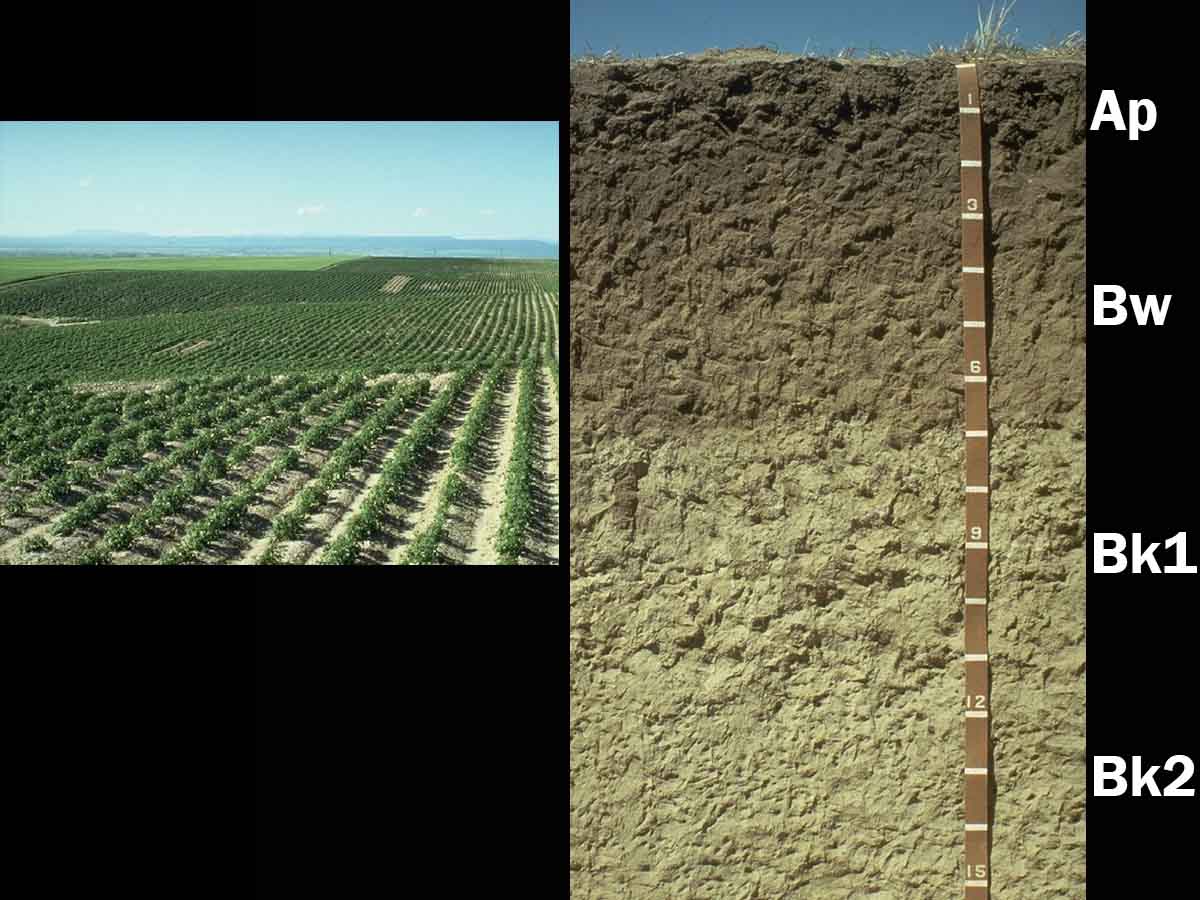
Calcic Haploxeroll (coarse-silty, mixed, superactive, frigid), Madison County, Idaho — This very deep soil belongs to the Rexburg series and has developed on loess-mantled fans, foothills and basalt plains. These soils are used extensively for both irrigated and non-irrigated crop production. The landscape on the left shows some irrigated “famous” Idaho potatoes. Calcium carbonate has been leached deeper in the profile, creating a calcic (Bk) horizon. The relatively cold, dry climate has slowed soil development and very little neoformation or subsoil accumulation of clay has taken place – the Bw horizon only contains 8-18 percent clay. CaCO3 content of the calcic horizon typically ranges from approximately 15-30 percent. Mean annual precipitation is approximately 360 mm (14 inches). Scale is in decimeters. (Images from University of Idaho)
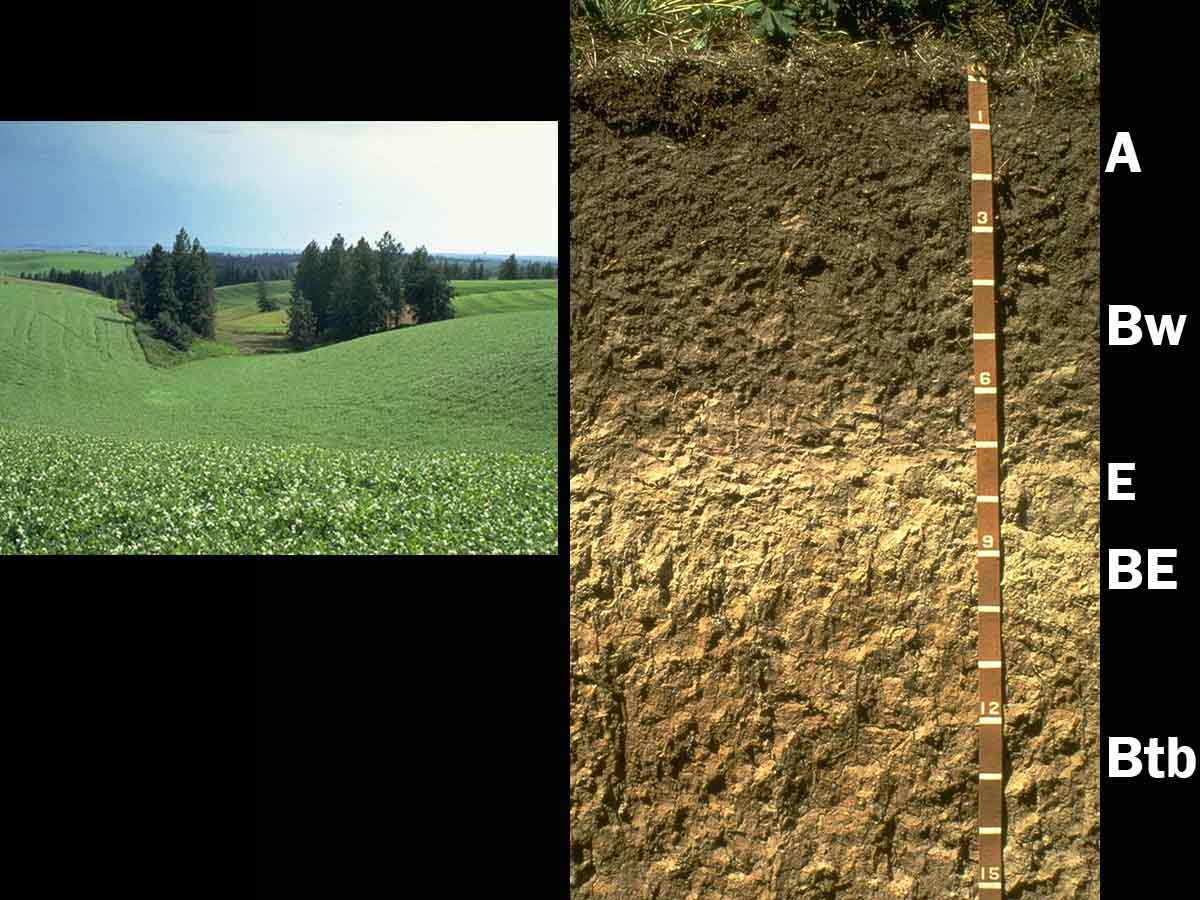
Oxyaquic Argixeroll (fine-silty, mixed, superactive, mesic), Latah County, Idaho — This soil is a member of the Southwick series and has developed in loess under ponderosa pine (Pinus ponderosa) forest. Mean annual precipitation is approximately 610 mm (24 inches). The significant grass/shrub understory associated with ponderosa pine forest in this area contributes to the development of a mollic epipedon. The A-Bw horizon sequence has formed mostly in Holocene loess while the Btb horizon represents the upper part of a Middle to Late Wisconsin paleosol. The Btb horizon is hydraulically restrictive with a saturated hydraulic conductivity of approximately 0.1 cm/day. Water is perched above this horizon for a period extending from late November through May. Scale is in decimeters. (Images from University of Idaho)
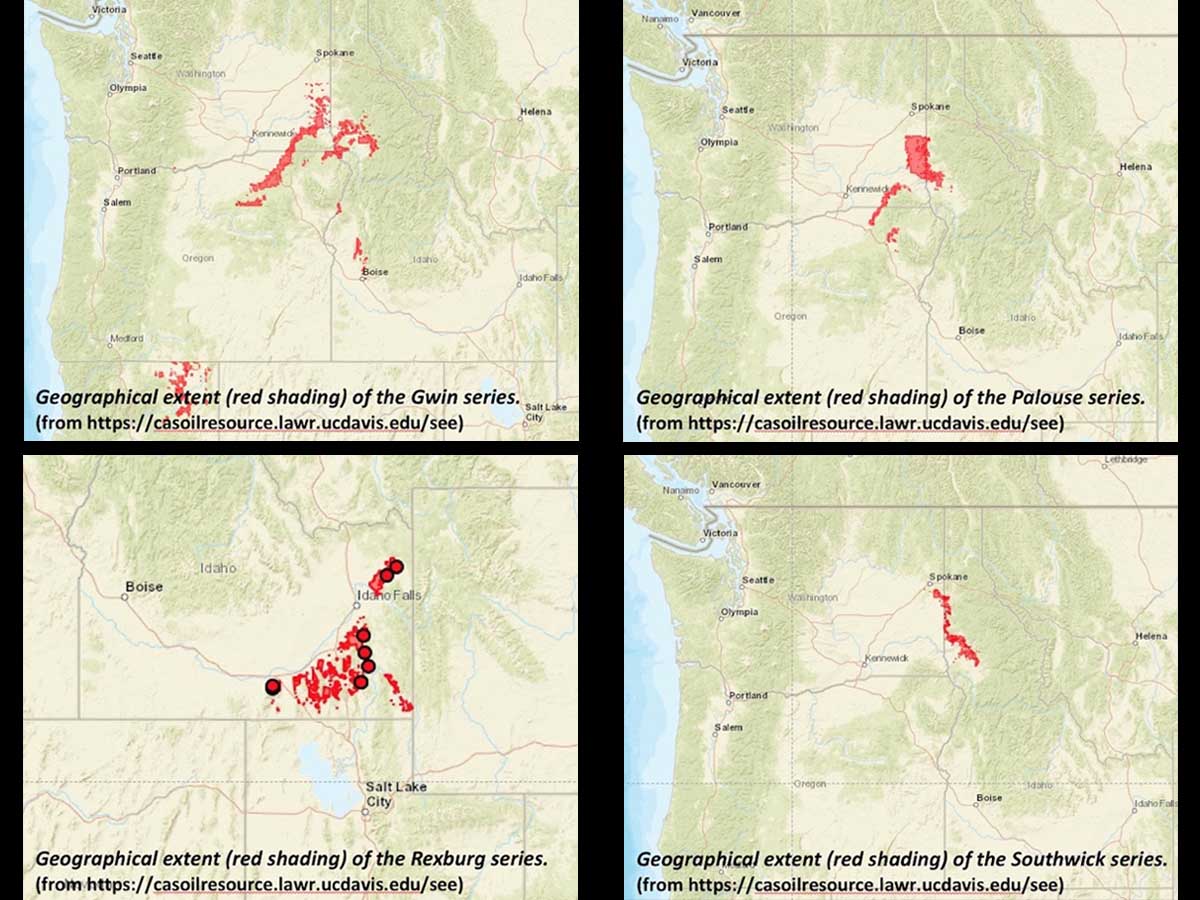
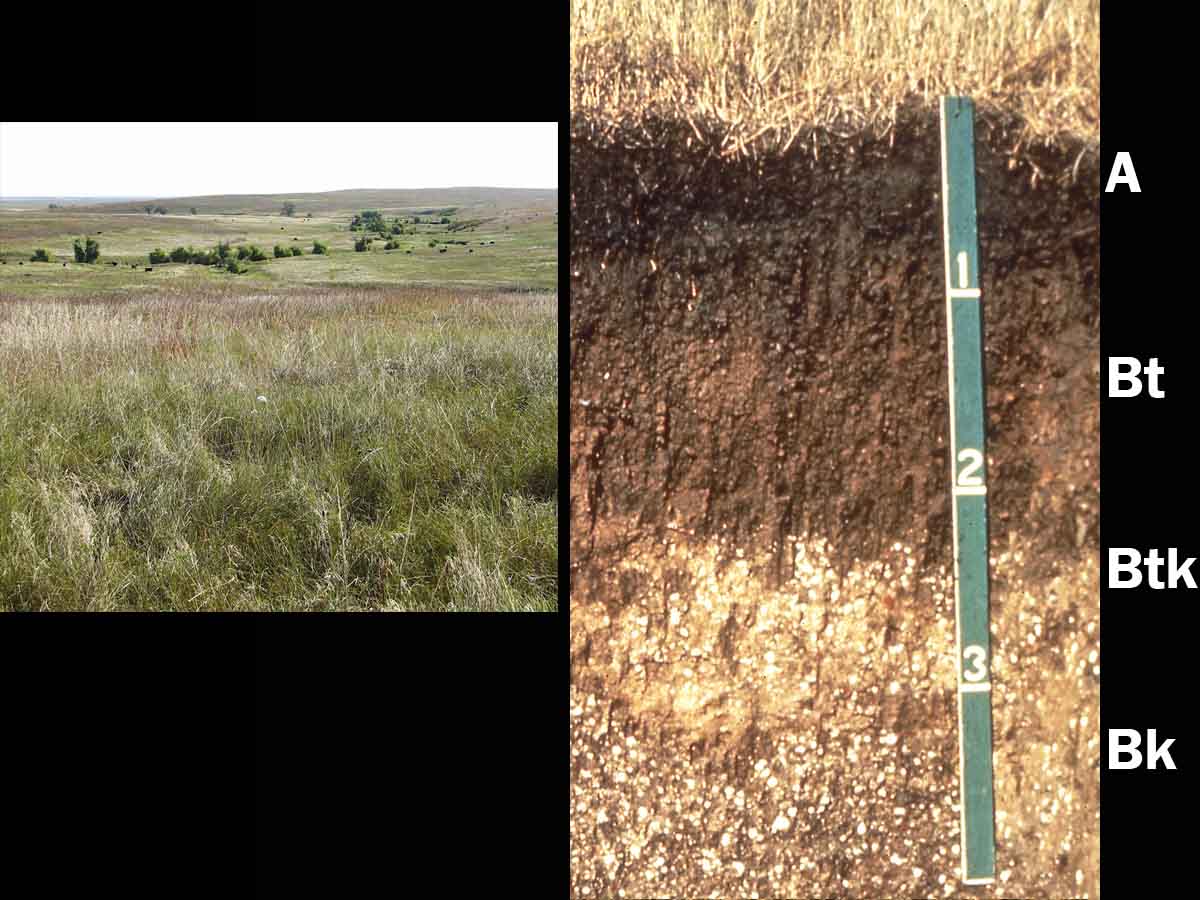
Typic Argiustoll, South Dakota — This profile illustrates the typical morphology associated with soils formed under grassland vegetation in the drier areas of the Great Plains region, such as seen in the landscape image from the Fort Pierre National Grassland. The thick, dark A horizon has developed as a result of the proliferation and subsequent decomposition of fine and very fine roots. This process is known as melanization. Secondary carbonates are clearly visible as the white nodules in the subsoil, indicating that they have been translocated in the profile and re-precipitated. As CaCO3 has been leached from the upper part of the soil, clay movement and accumulation has resulted in the formation of an argillic Bt horizon. Scale is in feet. (Landscape image from USDA-Forest Service; soil profile image from the Soil Science Society of America Marbut Memorial Slide Set)
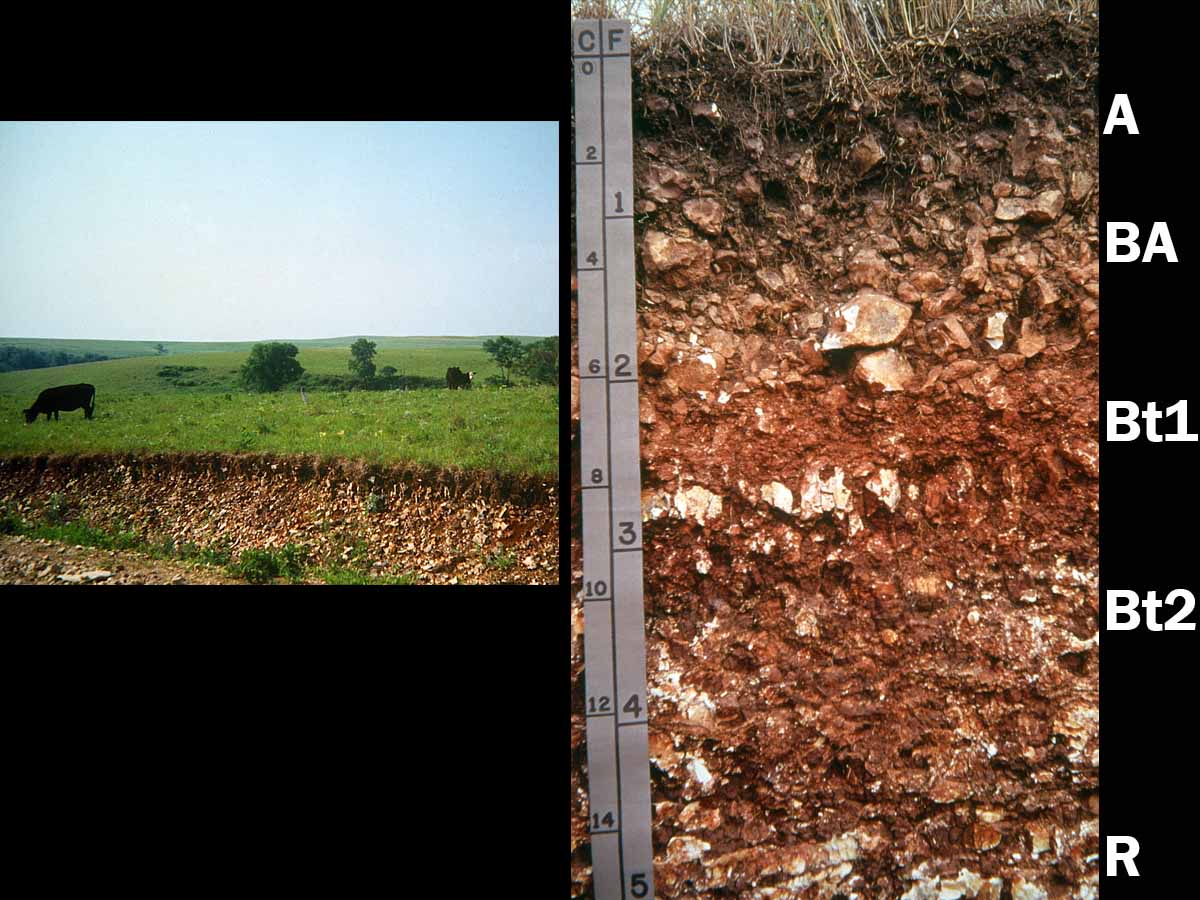
Udic Argiustoll (clayey-skeletal, smectitic, mesic), eastern Kansas — This deep, rocky soil is a member of the Florence series and has formed in cherty limestone. These soils receive approximately 810 mm (32 inches) of annual precipitation and represent the moister end of the Ustolls. Significant accumulation of clay has occurred in the argillic Bt horizon, which typically contains 50-80 percent clay. Hard cherty limestone bedrock (R) can be seen at the bottom of the profile. (Images reproduced from Soils of the Great Plains: Land Use, Crops and Grasses by Andrew R. Aandahl by permission of the University of Nebraska Press. Copyright 1982 by the University of Nebraska Press)
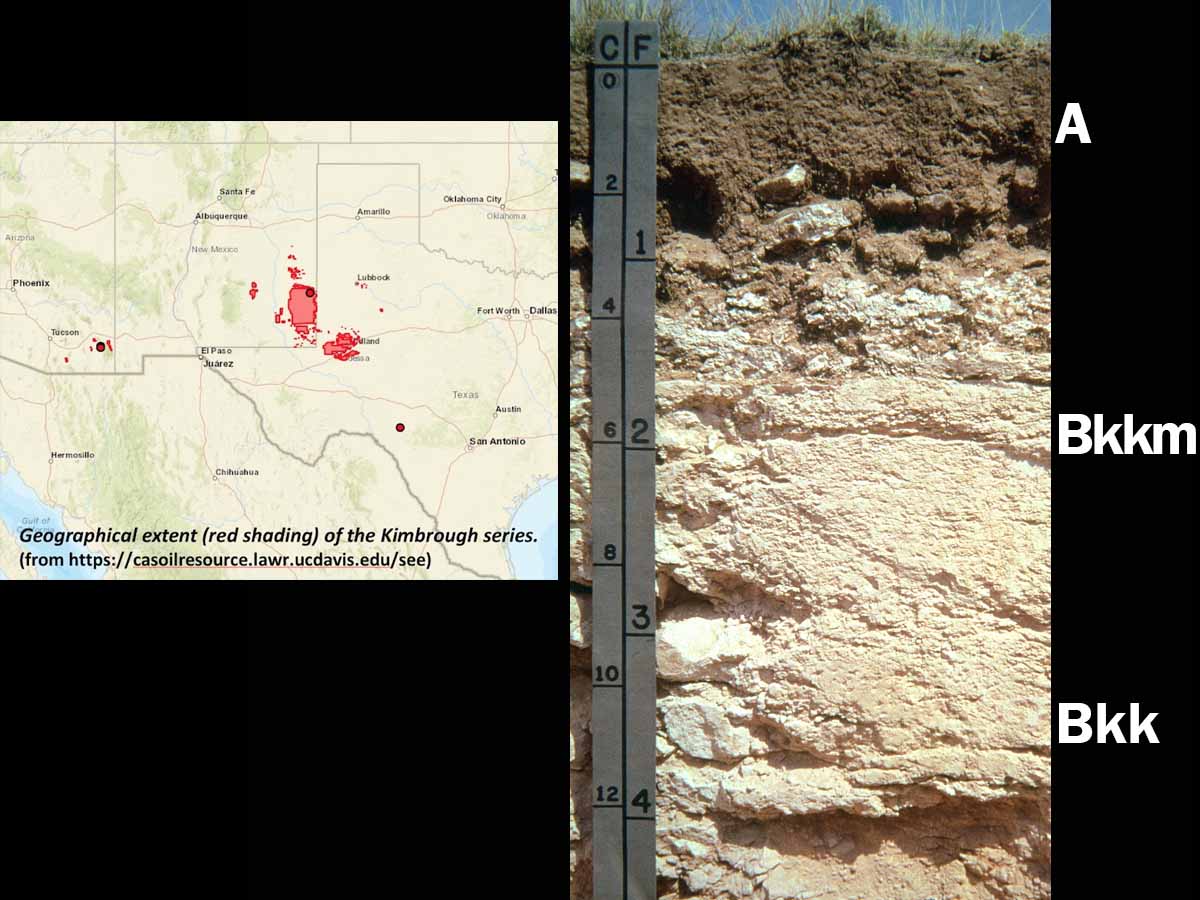
Petrocalcic Calciustoll (loamy, siliceous, superactive, thermic, shallow), New Mexico — This shallow soil belongs to the Kimbrough series. These soils only receive approximately 405 mm (16 inches) of annual precipitation and represent the dry end of the Ustolls. The thick CaCO3-cemented petrocalcic (Bkkm) horizon is also referred to as caliche and has likely taken a few hundred thousand years to achieve this degree of development. Because of the low rainfall and shallow depth to the petrocalcic horizon, most of these soils are used for rangeland. (Image reproduced from Soils of the Great Plains: Land Use, Crops and Grasses by Andrew R. Aandahl by permission of the University of Nebraska Press. Copyright 1982 by the University of Nebraska Press)
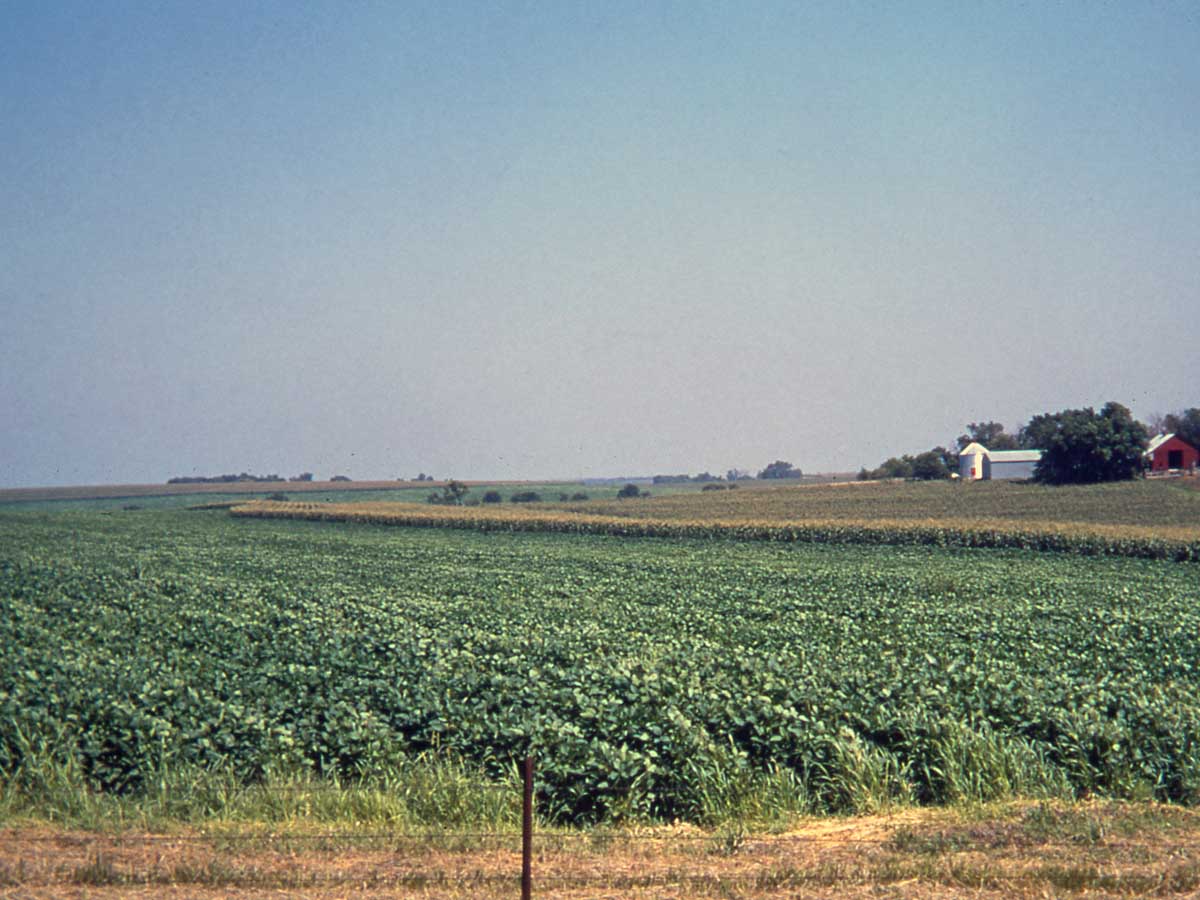
Argiudoll Landscape, Central Great Plains — This landscape is typical of loess-mantled till plains of southern Iowa and northwestern Missouri. Mean annual precipitation ranges from approximately 700-1,100 mm (28-43 inches). Although now mostly in agricultural production, these soils once supported tall grass prairie, including big bluestem (Andropogon gerardii) and western wheatgrass (Pascopyrum smithii). (Image reproduced from Soils of the Great Plains: Land Use, Crops and Grasses by Andrew R. Aandahl by permission of the University of Nebraska Press. Copyright 1982 by the University of Nebraska Press)
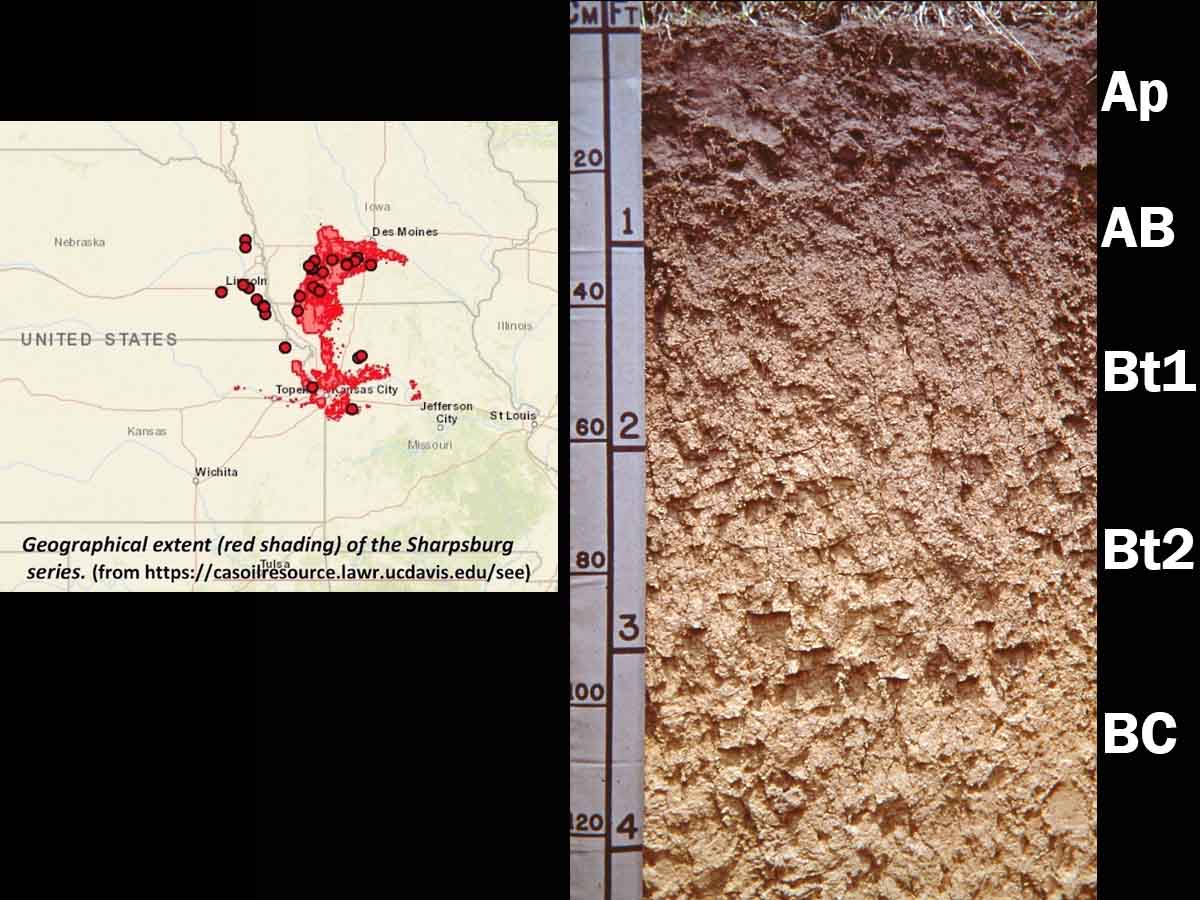
Typic Argiudoll (fine, smectitic, mesic) — This very deep soil is a member of the Sharpsburg series. These soils have formed in deep loess under tall grass prairie. Mean annual precipitation is approximately 900 mm (35 inches), which has been sufficient to leach CaCO3 from the profile. This has allowed clay movement and the formation of an argillic horizon (Bt horizons) with textures of silty clay loam or silty clay. (Image reproduced from Soils of the Great Plains: Land Use, Crops and Grasses by Andrew R. Aandahl by permission of the University of Nebraska Press. Copyright 1982 by the University of Nebraska Press)
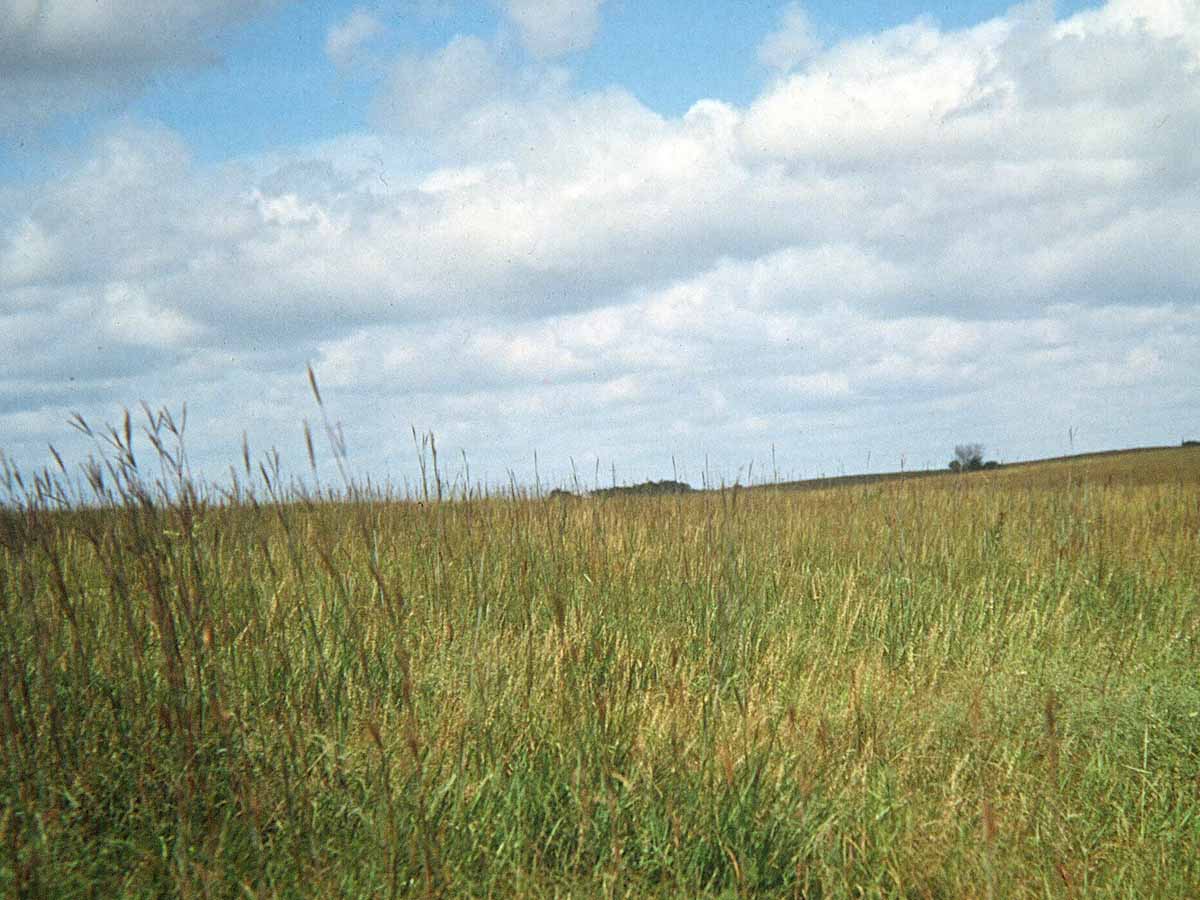
Argiudoll Landscape, southeastern Nebraska — This landscape is typical of till plains of southeastern Nebraska and northeastern Kansas. Mean annual precipitation ranges from approximately 740-990 mm (29-39 inches). Soils have developed under tall and mid grass prairie. Grasses such as big bluestem (Andropogon gerardii) shown here have extensive root systems, which contribute to the formation of a mollic epipedon. (Image reproduced from Soils of the Great Plains: Land Use, Crops and Grasses by Andrew R. Aandahl by permission of the University of Nebraska Press. Copyright 1982 by the University of Nebraska Press)
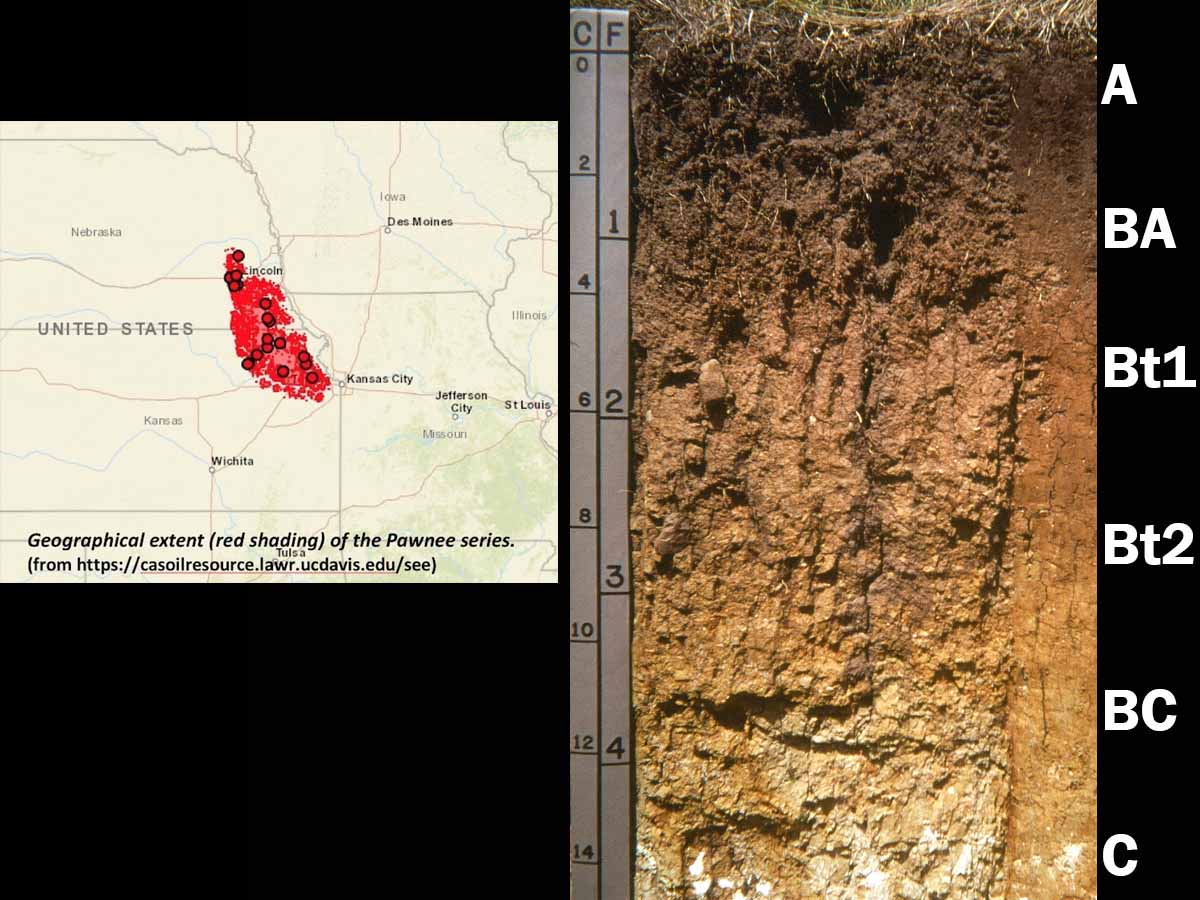
Oxyaquic Vertic Argiudoll (fine, smectitic, mesic), southeastern Nebraska — This very deep soil belongs to the Pawnee series. These soils have formed under tall grass prairie on dissected till plains. Mean annual precipitation is approximately 860 mm (34 inches). The argillic Bt horizon in this soil is well developed — it typically has strongly expressed prismatic structure, extends to a depth of 1 m or more, and has clay textures. This horizon perches water above it during late winter/early spring. (Image reproduced from Soils of the Great Plains: Land Use, Crops and Grasses by Andrew R. Aandahl by permission of the University of Nebraska Press. Copyright 1982 by the University of Nebraska Press)
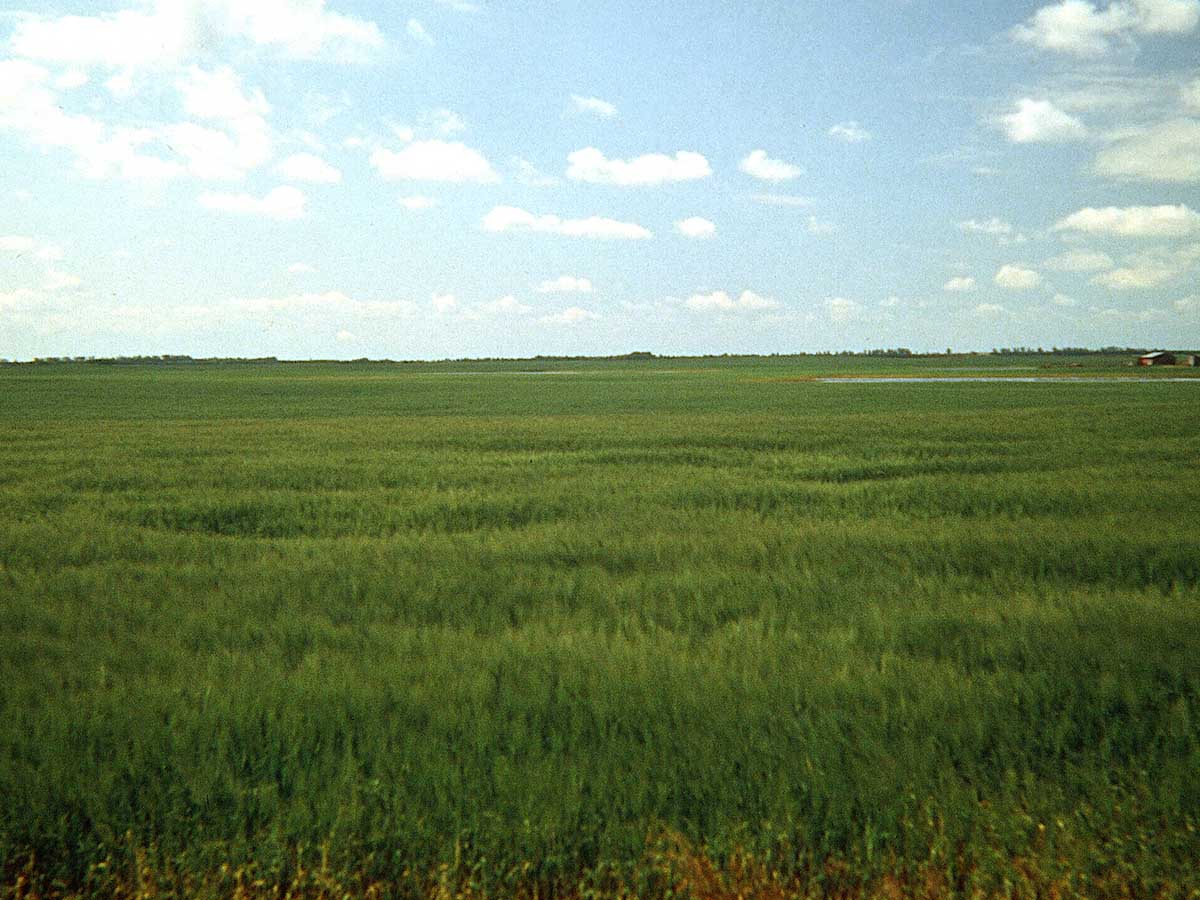
Natrudoll Landscape, North Dakota — This nearly level till plain receives approximately 530 mm (21 inches) of annual precipitation and is dominated by Mollisols. The areas of poorer plant growth that are visible occur on soils with a natric (Na-affected) horizon, which are classified as Natrudolls. (Image reproduced from Soils of the Great Plains: Land Use, Crops and Grasses by Andrew R. Aandahl by permission of the University of Nebraska Press. Copyright 1982 by the University of Nebraska Press)
